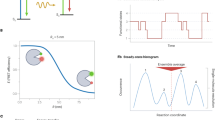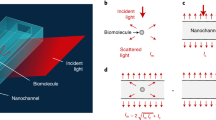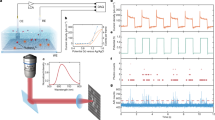Abstract
Most chemistry and biology occurs in solution, in which conformational dynamics and complexation underlie behaviour and function. Single-molecule techniques1 are uniquely suited to resolving molecular diversity and new label-free approaches are reshaping the power of single-molecule measurements. A label-free single-molecule method2,3,4,5,6,7,8,9,10,11,12,13,14,15,16 capable of revealing details of molecular conformation in solution17,18 would allow a new microscopic perspective of unprecedented detail. Here we use the enhanced light–molecule interactions in high-finesse fibre-based Fabry–Pérot microcavities19,20,21 to detect individual biomolecules as small as 1.2 kDa, a ten-amino-acid peptide, with signal-to-noise ratios (SNRs) >100, even as the molecules are unlabelled and freely diffusing in solution. Our method delivers 2D intensity and temporal profiles, enabling the distinction of subpopulations in mixed samples. Notably, we observe a linear relationship between passage time and molecular radius, unlocking the potential to gather crucial information about diffusion and solution-phase conformation. Furthermore, mixtures of biomolecule isomers of the same molecular weight and composition but different conformation can also be resolved. Detection is based on the creation of a new molecular velocity filter window and a dynamic thermal priming mechanism that make use of the interplay between optical and thermal dynamics22,23 and Pound–Drever–Hall (PDH) cavity locking24 to reveal molecular motion even while suppressing environmental noise. New in vitro ways of revealing molecular conformation, diversity and dynamics can find broad potential for applications in the life and chemical sciences.
This is a preview of subscription content, access via your institution
Access options
Access Nature and 54 other Nature Portfolio journals
Get Nature+, our best-value online-access subscription
$29.99 / 30 days
cancel any time
Subscribe to this journal
Receive 51 print issues and online access
$199.00 per year
only $3.90 per issue
Buy this article
- Purchase on Springer Link
- Instant access to full article PDF
Prices may be subject to local taxes which are calculated during checkout





Similar content being viewed by others
Data availability
A representative sample of the raw data supporting the findings of this work is openly available on figshare at https://figshare.com/articles/dataset/Label-free_detection_and_profiling_of_individual_solution-phase_molecules-_sample_raw_data/25463965, under the title ‘Label-free detection and profiling of individual solution-phase molecules- sample raw data’, with the following ref. 64. The data are associated with Figs. 2 and 3. The sample data are in .csv format and available without restrictions.
References
Moerner, W. E. Single-molecule spectroscopy, imaging, and photocontrol: foundations for super-resolution microscopy (Nobel Lecture). Angew. Chem. Int. Edn 54, 8067–8093 (2015).
Li, N. et al. Photonic resonator interferometric scattering microscopy. Nat. Commun. 12, 1744 (2021).
Mauranyapin, N. P., Madsen, L. S., Taylor, M. A., Waleed, M. & Bowen, W. P. Evanescent single-molecule biosensing with quantum-limited precision. Nat. Photonics 11, 477–481 (2017).
Piliarik, M. & Sandoghdar, V. Direct optical sensing of single unlabelled proteins and super-resolution imaging of their binding sites. Nat. Commun. 5, 4495 (2014).
Ortega Arroyo, J. et al. Label-free, all-optical detection, imaging, and tracking of a single protein. Nano Lett. 14, 2065–2070 (2014).
Taylor, R. W. & Sandoghdar, V. Interferometric scattering microscopy: seeing single nanoparticles and molecules via Rayleigh scattering. Nano Lett. 19, 4827–4835 (2019).
Young, G. et al. Quantitative mass imaging of single biological macromolecules. Science 360, 423–427 (2018).
Yu, D. et al. Whispering-gallery-mode sensors for biological and physical sensing. Nat. Rev. Methods Primers 1, 83 (2021).
Heylman, K. D. et al. Optical microresonators for sensing and transduction: a materials perspective. Adv. Mater. 29, 1700037 (2017).
Zijlstra, P., Paulo, P. M. R. & Orrit, M. Optical detection of single non-absorbing molecules using the surface plasmon resonance of a gold nanorod. Nat. Nanotechnol. 7, 379–382 (2012).
Baaske, M. D., Foreman, M. R. & Vollmer, F. Single-molecule nucleic acid interactions monitored on a label-free microcavity biosensor platform. Nat. Nanotechnol. 9, 933–939 (2014).
Dantham, V. R. et al. Label-free detection of single protein using a nanoplasmonic-photonic hybrid microcavity. Nano Lett. 13, 3347–3351 (2013).
Yu, W., Jiang, W. C., Lin, Q. & Lu, T. Cavity optomechanical spring sensing of single molecules. Nat. Commun. 7, 12311 (2016).
Su, J., Goldberg, A. F. & Stoltz, B. M. Label-free detection of single nanoparticles and biological molecules using microtoroid optical resonators. Light Sci. Appl. 5, e16001 (2016).
Špačková, B. et al. Label-free nanofluidic scattering microscopy of size and mass of single diffusing molecules and nanoparticles. Nat. Methods 19, 751–758 (2022).
Baaske, M. D., Asgari, N., Punj, D. & Orrit, M. Nanosecond time scale transient optoplasmonic detection of single proteins. Sci. Adv. 8, 5576 (2022).
Wilson, H. & Wang, Q. ABEL-FRET: tether-free single-molecule FRET with hydrodynamic profiling. Nat. Methods 18, 816–820 (2021).
Wang, Q., Goldsmith, R. H., Jiang, Y., Bockenhauer, S. D. & Moerner, W. E. Probing single biomolecules in solution using the anti-Brownian electrokinetic (ABEL) trap. Acc. Chem. Res. 45, 1955–1964 (2012).
Vallance, C., Trichet, A. A. P., James, D., Dolan, P. R. & Smith, J. M. Open-access microcavities for chemical sensing. Nanotechnology 27, 274003 (2016).
Hunger, D. et al. A fiber Fabry–Perot cavity with high finesse. New J. Phys. 12, 065038 (2010).
Kohler, L., Mader, M., Kern, C., Wegener, M. & Hunger, D. Tracking Brownian motion in three dimensions and characterization of individual nanoparticles using a fiber-based high-finesse microcavity. Nat. Commun. 12, 6385 (2021).
Carmon, T., Yang, L. & Vahala, K. J. Dynamical thermal behavior and thermal self-stability of microcavities. Opt. Express 12, 4742–4750 (2004).
Brachmann, J. F. S., Kaupp, H., Hänsch, T. W. & Hunger, D. Photothermal effects in ultra-precisely stabilized tunable microcavities. Opt. Express 24, 21205–21215 (2016).
Black, E. D. An introduction to Pound–Drever–Hall laser frequency stabilization. Am. J. Phys. 69, 79–87 (2001).
Moerner, W. E. & Fromm, D. P. Methods of single-molecule fluorescence spectroscopy and microscopy. Rev. Sci. Instrum. 74, 3597–3619 (2003).
Riback, J. A. et al. Commonly used FRET fluorophores promote collapse of an otherwise disordered protein. Proc. Natl Acad. Sci. USA 116, 8889–8894 (2019).
Zanetti-Domingues, L. C., Tynan, C. J., Rolfe, D. J., Clarke, D. T. & Martin-Fernandez, M. Hydrophobic fluorescent probes introduce artifacts into single molecule tracking experiments due to non-specific binding. PLoS One 8, 74200 (2013).
Dietz, M. S., Wehrheim, S. S., Harwardt, M.-L. I. E., Niemann, H. H. & Heilemann, M. Competitive binding study revealing the influence of fluorophore labels on biomolecular interactions. Nano Lett. 19, 8245–8249 (2019).
Friedel, M., Baumketner, A. & Shea, J.-E. Effects of surface tethering on protein folding mechanisms. Proc. Natl Acad. Sci. USA 103, 8396–8401 (2006).
Wang, Q. & Moerner, W. E. Single-molecule motions enable direct visualization of biomolecular interactions in solution. Nat. Methods 11, 555–558 (2014).
Vahala, K. J. Optical microcavities. Nature 424, 839–846 (2003).
Arnold, S., Shopova, S. I. & Holler, S. Whispering gallery mode bio-sensor for label-free detection of single molecules: thermo-optic vs. reactive mechanism. Opt. Express 18, 281–287 (2010).
Zhu, J. et al. On-chip single nanoparticle detection and sizing by mode splitting in an ultrahigh-Q microresonator. Nat. Photonics 4, 46–49 (2010).
Foreman, M. R., Keng, D., Treasurer, E., Lopez, J. R. & Arnold, S. Whispering gallery mode single nanoparticle detection and sizing: the validity of the dipole approximation. Opt. Lett. 42, 963–966 (2017).
Horak, E. H. et al. Exploring electronic structure and order in polymers via single-particle microresonator spectroscopy. Nano Lett. 18, 1600–1607 (2018).
Heylman, K. D. et al. Optical microresonators as single-particle absorption spectrometers. Nat. Photonics 10, 788–795 (2016).
Hümmer, T. et al. Cavity-enhanced Raman microscopy of individual carbon nanotubes. Nat. Commun. 7, 12155 (2016).
Hogan, L. T. et al. Toward real-time monitoring and control of single nanoparticle properties with a microbubble resonator spectrometer. ACS Nano 13, 12743–12757 (2019).
Trichet, A. A. P. et al. Nanoparticle trapping and characterization using open microcavities. Nano Lett. 16, 6172–6177 (2016).
Saavedra, C., Pandey, D., Alt, W., Pfeifer, H. & Meschede, D. Tunable fiber Fabry-Perot cavities with high passive stability. Opt. Express 29, 974–982 (2021).
Haustein, E. & Schwille, P. Fluorescence correlation spectroscopy: novel variations of an established technique. Annu. Rev. Biophys. Biomol. Struct. 36, 151–169 (2007).
Barnes, J. A., Gagliardi, G. & Loock, H.-P. Absolute absorption cross-section measurement of a submonolayer film on a silica microresonator. Optica 1, 75–83 (2014).
Baaske, M. D. & Vollmer, F. Optical observation of single atomic ions interacting with plasmonic nanorods in aqueous solution. Nat. Photonics 10, 733–739 (2016).
Dahmardeh, M., Mirzaalian Dastjerdi, H., Mazal, H., Köstler, H. & Sandoghdar, V. Self-supervised machine learning pushes the sensitivity limit in label-free detection of single proteins below 10 kDa. Nat. Methods 20, 442–447 (2023).
Torres, T. & Levitus, M. Measuring conformational dynamics: a new FCS-FRET approach. J. Phys. Chem. B 111, 7392–7400 (2007).
Kandula, H. N., Jee, A.-Y. & Granick, S. Robustness of FCS (fluorescence correlation spectroscopy) with quenchers present. J. Phys. Chem. A 123, 10184–10189 (2019).
Kratz, K., Hellweg, T. & Eimer, W. Structural changes in PNIPAM microgel particles as seen by SANS, DLS, and EM techniques. Polymer 42, 6631–6639 (2001).
Hoo, C. M., Starostin, N., West, P. & Mecartney, M. L. A comparison of atomic force microscopy (AFM) and dynamic light scattering (DLS) methods to characterize nanoparticle size distributions. J. Nanopart. Res. 10, 89–96 (2008).
Stetefeld, J., McKenna, S. A. & Patel, T. R. Dynamic light scattering: a practical guide and applications in biomedical sciences. Biophys. Rev. 8, 409–427 (2016).
Roy, P., Claude, J. B., Tiwari, S., Barulin, A. & Wenger, J. Ultraviolet nanophotonics enables autofluorescence correlation spectroscopy on label-free proteins with a single tryptophan. Nano Lett. 23, 497–504 (2023).
Jameson, D. M. & Ross, J. A. Fluorescence polarization/anisotropy in diagnostics and imaging. Chem. Rev. 110, 2685–2708 (2010).
Bohren, C. F. & Huffman, D. R. Absorption and Scattering of Light by Small Particles (Wiley, 1998).
Lukić, B. et al. Motion of a colloidal particle in an optical trap. Phys. Rev. E 76, 011112 (2007).
Gaiduk, A., Yorulmaz, M., Ruijgrok, P. V. & Orrit, M. Room-temperature detection of a single molecule’s absorption by photothermal contrast. Science 330, 353–356 (2010).
Brandstätter, B. et al. Integrated fiber-mirror ion trap for strong ion-cavity coupling. Rev. Sci. Instrum. 84, 123104 (2013).
Gallego, J. et al. High-finesse fiber Fabry–Perot cavities: stabilization and mode matching analysis. Appl. Phys. B 122, 47 (2016).
Demtröder, W. Laser Spectroscopy 1: Basic Principles (Springer, 2014).
van Oss, C. J. et al. Macroscopic-scale surface properties of streptavidin and their influence on aspecific interactions between streptavidin and dissolved biopolymers. Colloids Surf. B Biointerfaces 30, 25–36 (2003).
Krishnamurthy, V. M. et al. Carbonic anhydrase as a model for biophysical and physical-organic studies of proteins and protein–ligand binding. Chem. Rev. 108, 946–1051 (2008).
Agić, D., Brkić, H., Kazazić, S., Tomić, A. & Abramić, M. Aprotinin interacts with substrate-binding site of human dipeptidyl peptidase III. J. Biomol. Struct. Dyn. 37, 3596–3606 (2019).
Evan, G. I., Lewis, G. K., Ramsay, G. & Michael Bishop, J. Isolation of monoclonal antibodies specific for human c-myc proto-oncogene product. Mol. Cell. Biol. 5, 3610–3616 (1985).
Hilvo, M. et al. Biochemical characterization of CA IX, one of the most active carbonic anhydrase isozymes. J. Biol. Chem. 283, 27799–27809 (2008).
Novais, S., Ferreira, M. S. & Pinto, J. L. Determination of thermo-optic coefficient of ethanol-water mixtures with optical fiber tip sensor. Opt. Fiber Technol. 45, 276–279 (2018).
Needham, L.-M. et al. Label-free detection and profiling of individual solution-phase molecules—sample raw data. figshare https://doi.org/10.6084/m9.figshare.25463965.v1 (2024).
Acknowledgements
This work was mainly financed by the National Institutes of Health (NIH, R01GM136981), with resonator construction supported by the Q-NEXT Quantum Center, a U.S. Department of Energy (DOE), Office of Science, National Quantum Information Science Research Centers, under award number DE-FOA-0002253. Further instrumentation development was supported by the Center for Molecular Quantum Transduction, an Energy Frontier Research Center financed by DOE, Office of Science, BES under award DE-SC0021314, the National Science Foundation (NSF) Quantum Leap Challenge Institute for Hybrid Quantum Architectures and Networks, award no. 2016136, and by Schmidt Futures. L.-M.N. was partially financed by the European Union’s Horizon 2020 research and innovation programme under the Marie Skłodowska-Curie grant agreement no. 886216. E.R.C. was financed by the NIH (MH061876 and NS097362). H.P. was financed by the Deutsche Forschungsgemeinschaft (DFG, German Research Foundation) under Germany’s Excellence Strategy – Cluster of Excellence Matter and Light for Quantum Computing (ML4Q) EXC 2004/1 – 390534769. We thank D. Hunger, T. Northup and S. Vanga for help in initial fibre mirror and microcavity fabrication, X. Huang and B. Cullinane for conversations on diffusion, M. Saffman for early conversations on fibre microcavities and B. Thompson and T. Drier for instrumentation development.
Author information
Authors and Affiliations
Contributions
R.H.G. and L.-M.N. conceptualized experiments. B.S.S., Y.P. and A.J.B., along with L.T., performed the CO2 fibre ablation, with help from J.S., L.C.K., J.S.K. and H.P. L.-M.N., J.K.R. and S.W. constructed the cavities, with help from C.H.V. L.-M.N. and J.K.R. performed single-protein experiments and protein data analysis. D.S.-B. performed autocorrelation analysis. J.K.R. and L.-M.N. performed protein and DNA mixture experiments. C.S. and R.H.G. devised experiments to confirm the mechanism. C.S., J.K.R. and L.-M.N. performed LBW experiments, noise characterization and photothermal bandwidth quantification. C.S. and D.S.-B. performed simulations. A.J.F. and B.M. wrote the hardware code. Z.Z. and E.R.C. designed and Z.Z. purified DNA constructs. R.H.G., L.-M.N., C.S., J.K.R. and D.S.-B. wrote the manuscript.
Corresponding author
Ethics declarations
Competing interests
R.H.G. and L.-M.N. have submitted PCT/US2023/079347, ‘Methods and systems for detecting diffusing single particles’, filed 10 November 2023.
Peer review
Peer review information
Nature thanks Michel Orrit, Judith Su and the other, anonymous, reviewer(s) for their contribution to the peer review of this work.
Additional information
Publisher’s note Springer Nature remains neutral with regard to jurisdictional claims in published maps and institutional affiliations.
Extended data figures and tables
Extended Data Fig. 1 Zoomed-in view of single-molecule signals.
Representative 44-ms traces of proteins streptavidin, carbonic anhydrase, aprotinin and Myc-tag perturbing the cavity mode in both transmission and reflection. Data collected in cavity one.
Extended Data Fig. 2 Linearity of peak count with concentration.
Number of detected peaks induced by Myc-tag as a function of the protein concentration. Error bars represent the standard deviation across datasets. This scaling demonstrates that the peaks are induced by interactions between biomolecules and the cavity mode. Data collected in cavity two.
Extended Data Fig. 3 Poisson distribution of single-molecule signal arrival times.
Statistical analysis of the time intervals between single-molecule events for proteins streptavidin, carbonic anhydrase and Myc-tag. This analysis shows mono-exponential decays illustrating the underlying Poisson behaviour of the experiment and providing evidence of single-molecule detection.
Extended Data Fig. 4 Detection of protein molecules in buffer.
Single-molecule transients of aprotinin are readily observed in PBS buffer, whereas the pure PBS buffer and pure water are devoid of single-molecule signals.
Extended Data Fig. 5 Detection of signals sampled at 500 kHz.
Single diffusion events of <1 nm protein, Myc-tag, are resolvable with 2 μs temporal resolution. Representative single Myc-tag events collected with 500 kHz acquisition frequency. Data collected using cavity two at a concentration of 1 pM.
Extended Data Fig. 6 Histograms of detection events in mixtures.
a–c, Histograms showing extracted temporal widths and peak prominences of transmitted signals of a binary DNA Y-junction:duplex mixture (a; Supplementary Table 1), the mixture spiked with extra amounts of the pure Y-junction (b) and the mixture spiked with extra amounts of pure duplex (c).
Extended Data Fig. 7 Staggered detection from mixtures.
a,b, Scatter plots of peak prominence versus peak number showing consistency of molecular populations throughout the duration of an experiment and minimal cavity mode wandering for a binary mixture of aprotinin and Myc-tag (a) and a binary mixture of a DNA Y-junction and duplex (b; Supplementary Table 1).
Extended Data Fig. 8 Simulation of microcavity resonant mode.
Simulated cavity mode given the mirror properties of cavity one (Supplementary Table 5) showing the normalized square of the electric field, which is proportional to the total energy stored in the cavity. The zoomed image shows a particle localized in an antinode in the centre of the optical mode.
Extended Data Fig. 9 Photothermally distorted cavity resonance scan.
Photothermal-induced broadening of the transmitted cavity resonance in water, collected under cavity-length tuning at two different pump wavelengths. The blueshift in pump wavelength shifts the resonance position to lower piezo ramp voltage, demonstrating that increased piezo ramp voltage corresponds to increased cavity length. Furthermore, the direction of the broadening is indicative of a negative thermo-optic coefficient of the medium, as is expected in water. Despite the low circulating power (5.5 mW), photothermal broadening was apparent and enabled the high sensitivity of this measurement. The smaller peaks originate from polarization splitting owing to the birefringence of the cavity mode. Data collected with cavity four.
Extended Data Fig. 10 Replication of single-molecule-like signals by pulsing the length of the microcavity.
a, Transmitted intensity of locked cavity showing perturbations to the lock when voltage pulses are applied to the piezos at a frequency of 1 Hz. b, The applied pulse, input power and cavity-locking parameters can be optimized to mimic signals induced by diffusing molecules. a–d, The step-up voltage (grey) produced a steep reduction of the locked transmission signal as a result of the photothermal effect (a). This was followed by a brief recovery to the locked state by the PI feedback loop (b), followed by a second descent of the transmission signal as the step-up voltage of the pulse shifts the cavity in the opposite direction (c). Finally, the PI control recovers the locked state (d). Data collected with cavity four.
Supplementary information
Supplementary Information
This file contains DNA samples, simulations and calculations, additional discussion, Supplementary Tables 1–5, Supplementary Figures 1–20 and supplementary references.
Rights and permissions
Springer Nature or its licensor (e.g. a society or other partner) holds exclusive rights to this article under a publishing agreement with the author(s) or other rightsholder(s); author self-archiving of the accepted manuscript version of this article is solely governed by the terms of such publishing agreement and applicable law.
About this article
Cite this article
Needham, LM., Saavedra, C., Rasch, J.K. et al. Label-free detection and profiling of individual solution-phase molecules. Nature (2024). https://doi.org/10.1038/s41586-024-07370-8
Received:
Accepted:
Published:
DOI: https://doi.org/10.1038/s41586-024-07370-8
Comments
By submitting a comment you agree to abide by our Terms and Community Guidelines. If you find something abusive or that does not comply with our terms or guidelines please flag it as inappropriate.



